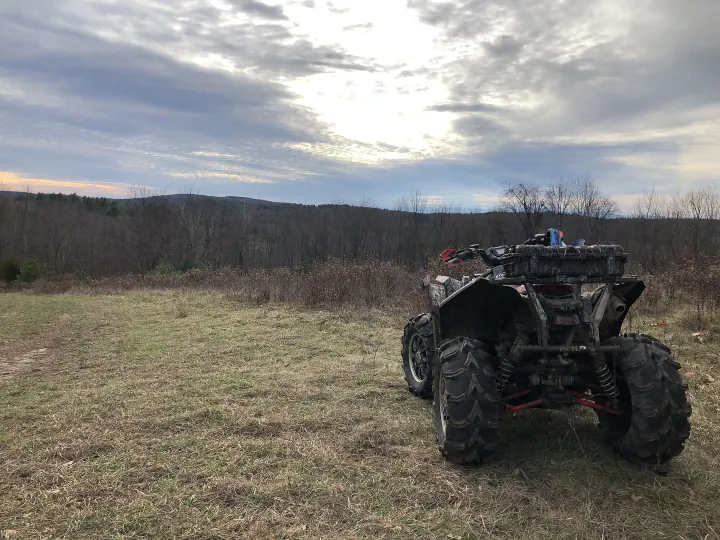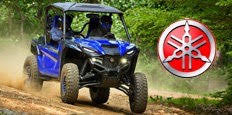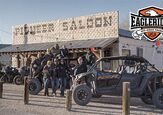How Do You Stay Hydrated While ATVing?

Staying hydrated while enjoying ATVing (All-Terrain Vehicle riding) is essential for your health and safety in order to have a successful day on the trails. Riding an ATV—and, yes, driving side-by-side (SxS)—involves physical exertion and exposure to the elements, which can lead to dehydration if you're not careful. Here's a guide on how to stay hydrated while ATVing.
Understanding Hydration Needs:
Assess Your Requirements: Before setting out on your ATV adventure, understand your hydration needs. Factors like weather, duration of the ride, and your body's individual requirements play a crucial role.
Hydration Calculation:
A general rule is to drink at least eight to 10 cups (64-80 ounces) of water per day, but during physical activities like ATVing, you might need more. Calculate your water intake by considering the duration of the ride and sweating rates. Yours truly prefers to err on the side of caution and prepare for excess and well above average water and sports drink intake on most rides, especially those above around 75 degrees Fahrenheit.
Preparing for Hydration:
Pre-Ride Preparation: Start hydrating before hitting the trails. Drink 16 to 20 ounces of water or a sports drink at least one to two hours before you start riding. If you know it’s going to be exceptionally hot—over 90 degrees Fahrenheit is a good general reference number—start hydrating the day before the ride.
Invest in a good hydration pack or backpack with a hydration reservoir. These packs come in various sizes and hold water for convenient sipping while riding without needing to stop. Coolers are good options for those who don’t want to or can’t carry a hydration pack on their back. This may entail finding a creative way to strap it down to an ATV’s rack or in the bed of a UTV, but small, soft coolers can also be made to fit in traditional cargo boxes or bags if need be.
Hydration During the Ride:
Scheduled Stops: Plan regular stops during your ATV adventure to take breaks, stretch, and hydrate. Aim for a break every hour or so, depending on the intensity of the ride.
Hydration Timing:
Take small sips of water regularly rather than gulping down large amounts infrequently. Consistent hydration helps maintain your body's water balance. This goes for any physical activity, not just ATVing.
Electrolyte Balance:
Long rides can lead to electrolyte loss through sweating. Consider electrolyte-enhanced drinks or tablets to replenish sodium, potassium, and magnesium levels. And yet, the best thing you can drink is good old water. A sports drink like Gatorade or Powerade is fine here and there, but nothing hydrates like water does.
Environmental Considerations:
Weather Awareness: Hot weather increases the risk of dehydration. In such conditions, increase your water intake to compensate for excessive sweating. In this instance, you should carry more water than you expect to need.
Sun Protection:
Wear appropriate clothing, including UV-protective gear and a hat, to shield yourself from the sun. Sunburns can exacerbate dehydration. Likewise, moisture-wicking long sleeve shirts can help you stay cool and/or prevent sunburns.
Signs of Dehydration:
Recognizing Symptoms: Understand the signs of dehydration, such as dry mouth, fatigue, dizziness, and reduced urine output. If you experience any, stop and hydrate immediately.
Urine Color:
Monitor your urine color; a pale yellow color indicates proper hydration, while darker urine signals dehydration.
Additional Tips for Hydration
Avoid Alcohol and Caffeine:
While tempting, these beverages can contribute to dehydration. Stick to water or electrolyte-enhanced drinks. You should avoid alcohol while ATVing and UTVing anyways, and being that it actively dehydrates is another reason to save it for after the ride.
Fruits and Snacks:
Carry hydrating snacks like water-rich fruits (watermelon, oranges) and nuts to supplement your hydration.
Monitoring Hydration Levels:
If you're unsure about your hydration status, weigh yourself before and after the ride. Any weight loss is likely due to fluid loss and should be replenished.
Post-Ride Hydration:
Rehydration: After the ride, continue hydrating to replenish lost fluids. Drink water or a rehydration solution and eat a balanced meal to aid recovery.
Rest and Recovery:
Allow your body time to recover from the physical exertion. Adequate rest, coupled with hydration and nutrition, is crucial for recovery.
Conclusion:
Staying hydrated during ATVing is vital for your health and overall riding experience. It involves a combination of pre-ride preparation, strategic hydration during the ride, and post-ride recovery. Understanding your body's hydration needs, being aware of the signs of dehydration, and taking proactive measures to combat fluid loss are key to a safe and enjoyable ATV adventure.
Remember, everyone's hydration needs differ, so listen to your body and adjust your water intake accordingly. By prioritizing hydration and adopting these practices, you can ensure a more comfortable and safer ATV riding experience while exploring the great outdoors. Your body will thank you.

Ross hosts The Off the Road Again Podcast. He has been in the off-road world since he was a kid riding in the back of his dad’s YJ Wrangler. He works in marketing by day and in his free time contributes to Hooniverse, AutoGuide, and ATV.com, and in the past has contributed to UTV Driver, ATV Rider, and Everyday Driver. Ross drives a 2018 Lexus GX460 that is an ongoing build project featured on multiple websites and the podcast and spends his free time working on and riding ATVs.
More by Ross Ballot































